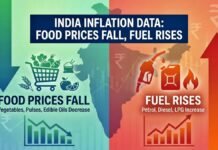
Key Points:
- Record High Prices: Global food prices have hit unprecedented levels, driven by conflicts, climate change, and economic disruptions.
- Climate Impact: Extreme weather events, such as floods and droughts, are reducing crop yields and destabilizing food supplies.
- Conflict Contribution: The war in Ukraine has severely disrupted global wheat, maize, and sunflower oil exports.
- Economic Pressures: Rising costs of fertilizers, energy, and transportation are further inflating food prices.
- Global Food Insecurity: Over 330 million people faced acute food insecurity in 2023, with the situation worsening in vulnerable regions.
New Delhi: The United Nations has reported that global food prices have reached an all-time high, exacerbating hunger and insecurity worldwide. A combination of geopolitical conflicts, climate-related disruptions, and economic pressures has created a perfect storm for the global food supply chain. This crisis is disproportionately affecting low-income countries and vulnerable populations.
Why Are Food Prices Surging?
The surge in food prices is the result of multiple interrelated factors:
- Climate Change
Extreme weather events such as droughts in Africa, floods in South Asia, and heatwaves in Europe have severely impacted crop yields. For instance, the El Niño phenomenon disrupted rice production in India in 2023, driving up global rice prices by 16%. Rising temperatures and erratic rainfall patterns are also reducing the reliability of farming worldwide. - Geopolitical Conflicts
The ongoing war in Ukraine has significantly disrupted global food exports. Ukraine and Russia are major suppliers of wheat, maize, sunflower oil, and fertilizers. The conflict has reduced exports from these regions, causing shortages and price hikes for essential commodities. For example, wheat prices increased by 2% globally due to supply uncertainties. - Economic Challenges
Rising energy costs have inflated transportation expenses for agricultural goods. Fertilizer shortages exacerbated by sanctions on Russia have further increased production costs for farmers. These economic pressures are passed on to consumers through higher food prices. - Supply Chain Disruptions
The COVID-19 pandemic exposed vulnerabilities in global supply chains that persist today. Delays in shipping and increased transportation costs have compounded the crisis. Export bans on staple foods by countries like India (rice) and Argentina (beef) have further restricted global supply.
Impact on Food Security
The consequences of soaring food prices are dire:
- Over 330 million people faced acute food insecurity in 2023, with hunger hotspots identified in regions like East Africa and the Middle East.
- Vulnerable populations in low-income countries are disproportionately affected as they spend a larger share of their income on food.
- Staple foods like cereals, vegetable oils, and dairy products have become unaffordable for million.
What Needs to Be Done?
Experts emphasize the urgent need for coordinated global action to address this crisis:
- Climate Adaptation: Investments in climate-resilient agriculture can help mitigate the impact of extreme weather events on crop yields.
- Conflict Resolution: Restoring peace in key agricultural regions like Ukraine is essential to stabilize global markets.
- Policy Reforms: Governments must prioritize reducing trade barriers and export restrictions to ensure a steady flow of essential commodities.
- Sustainable Practices: Transitioning to sustainable farming methods can reduce dependency on volatile inputs like fertilizers and fossil fuels.
Outlook
While some commodity prices have stabilized recently due to favorable harvests in certain regions (e.g., sugarcane crops in Brazil), experts warn that the underlying drivers of high food prices climate change and geopolitical instability remain unresolved. Without immediate action, the world risks deeper crises of hunger and malnutrition.
This record-breaking spike in food prices underscores the fragility of our interconnected global food systems. As conflicts persist and climate change accelerates, ensuring equitable access to affordable food will require unprecedented international cooperation.


















































